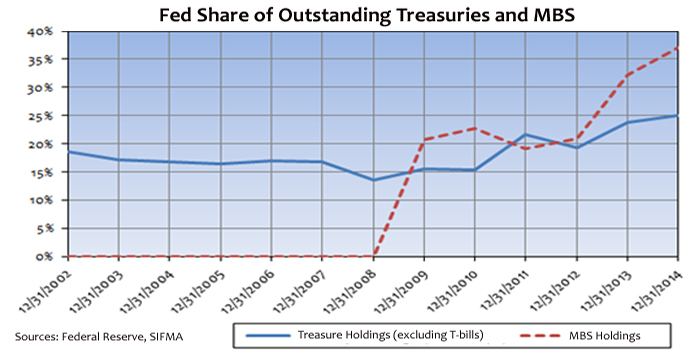The Barclays U.S. Aggregate Index is the most widely-used benchmark for both actively and passively managed domestic fixed income strategies. This benchmark should logically be an accurate representation of the investable universe of securities within the U.S. investment-grade bond market.
However, since the Federal Reserve's decision to begin buying Agency Guaranteed Mortgage-Backed Securities (MBS) in November of 2008, Barclays has retained Agency MBS on the Fed's balance sheet as part of its Aggregate Index holdings. The decision to include MBS held by the Federal Reserve (and thus unavailable for purchase by investors) as part of the Aggregate Index is even more curious, considering Barclays has always removed the Fed's Treasury bond holdings from the Index.
The current Barclays approach to include uninvestable securities in the Aggregate Index has, in effect, created a short squeeze in the Agency MBS market. The result has been beneficial for mortgage borrowers but led to over-valuation for Agency MBS; PIMCO estimates a 14 basis point impact on the average mortgage interest rate from the Barclays methodology. While 14 basis points may seem like a small amount, in today's low interest rate world, every basis point matters for fixed income investors.
Key Takeaways: With the Federal Reserve now holding more than a third of all Agency MBS and a quarter of all outstanding Treasury issuance - with no plans to sell their holdings anytime soon - Barclays should eliminate its inconsistent methodology and remove the Fed's Agency MBS holdings from the Aggregate Index. The result would be an improved and more easily replicable benchmark for fixed income investors in addition to a more realistic valuation for Agency MBS.
The material provided here is for informational use only. The views expressed are those of the author, and do not necessarily reflect the views of Penn Mutual Asset Management.
This material is for informational use only. The views expressed are those of the author, and do not necessarily reflect the views of Penn Mutual Asset Management. This material is not intended to be relied upon as a forecast, research or investment advice, and it is not a recommendation, offer or solicitation to buy or sell any securities or to adopt any investment strategy.
Opinions and statements of financial market trends that are based on current market conditions constitute judgment of the author and are subject to change without notice. The information and opinions contained in this material are derived from sources deemed to be reliable but should not be assumed to be accurate or complete. Statements that reflect projections or expectations of future financial or economic performance of the markets may be considered forward-looking statements. Actual results may differ significantly. Any forecasts contained in this material are based on various estimates and assumptions, and there can be no assurance that such estimates or assumptions will prove accurate.
Investing involves risk, including possible loss of principal. Past performance is no guarantee of future results. All information referenced in preparation of this material has been obtained from sources believed to be reliable, but accuracy and completeness are not guaranteed. There is no representation or warranty as to the accuracy of the information and Penn Mutual Asset Management shall have no liability for decisions based upon such information.
High-Yield bonds are subject to greater fluctuations in value and risk of loss of income and principal. Investing in higher yielding, lower rated corporate bonds have a greater risk of price fluctuations and loss of principal and income than U.S. Treasury bonds and bills. Government securities offer a higher degree of safety and are guaranteed as to the timely payment of principal and interest if held to maturity.
All trademarks are the property of their respective owners. This material may not be reproduced in whole or in part in any form, or referred to in any other publication, without express written permission.


